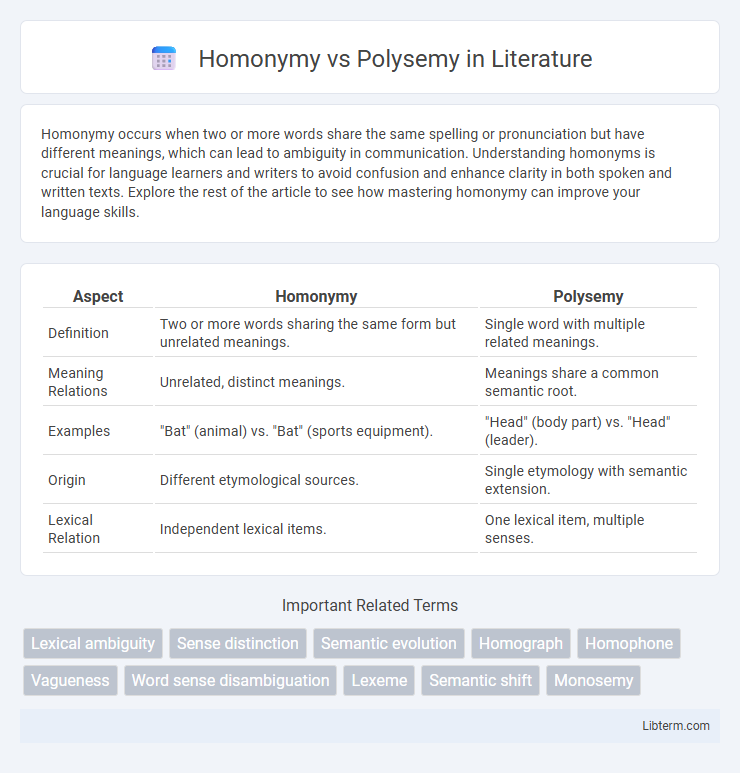Homonymy occurs when two or more words share the same spelling or pronunciation but have different meanings, which can lead to ambiguity in communication. Understanding homonyms is crucial for language learners and writers to avoid confusion and enhance clarity in both spoken and written texts. Explore the rest of the article to see how mastering homonymy can improve your language skills.
Table of Comparison
| Aspect | Homonymy | Polysemy |
|---|---|---|
| Definition | Two or more words sharing the same form but unrelated meanings. | Single word with multiple related meanings. |
| Meaning Relations | Unrelated, distinct meanings. | Meanings share a common semantic root. |
| Examples | "Bat" (animal) vs. "Bat" (sports equipment). | "Head" (body part) vs. "Head" (leader). |
| Origin | Different etymological sources. | Single etymology with semantic extension. |
| Lexical Relation | Independent lexical items. | One lexical item, multiple senses. |
Understanding Homonymy and Polysemy
Homonymy occurs when two words share the same spelling or pronunciation but have unrelated meanings, such as "bat" (animal) and "bat" (sports equipment). Polysemy involves a single word having multiple related meanings, like "bank" referring to a financial institution or the side of a river. Understanding the distinction helps in semantic analysis, improving natural language processing and lexical resource development.
Defining Homonymy: One Form, Different Meanings
Homonymy occurs when a single form, either a word or a phrase, possesses two or more entirely unrelated meanings, such as "bat" referring to both a flying mammal and a piece of sports equipment. Unlike polysemy, which involves related senses of a word, homonymous meanings share no semantic connection and are distinguishable only by context. Linguists identify homonyms through their distinct etymological origins and non-overlapping semantic fields.
Exploring Polysemy: Multiple Related Meanings
Polysemy occurs when a single word possesses multiple related meanings, often stemming from a core concept that evolves through context and usage, such as the word "bank," which can mean the side of a river or a financial institution, linked by the idea of a place of storage or support. This semantic relationship contrasts with homonymy, where words share form but have entirely unrelated meanings, such as "bat" (the animal) and "bat" (the sports equipment). Exploring polysemy reveals how language reflects cognitive processes of categorization and metaphorical extension, enriching vocabulary and communication efficiency by allowing one term to convey nuanced variations of a concept.
Key Differences Between Homonymy and Polysemy
Homonymy occurs when two words share the same spelling or pronunciation but have unrelated meanings, such as "bat" (an animal) and "bat" (a sports equipment). Polysemy involves a single word with multiple related meanings, like "mouth," referring to the part of a face or the opening of a river. The key difference lies in the semantic relationship: homonyms are semantically unrelated, while polysemous words have a common semantic origin or connection.
Linguistic Roots of Homonymy and Polysemy
Homonymy arises when two words share the same pronunciation or spelling but have entirely different etymological origins, such as "bat" (the animal) and "bat" (used in sports). Polysemy, in contrast, involves a single word branching into multiple related meanings while retaining a common linguistic root, exemplified by "head," which can refer to a body part, a leader, or the top of an object. The distinction between homonymy and polysemy is fundamentally rooted in their etymology, where polysemous words evolve from a single root through semantic extension, whereas homonyms originate from separate roots converging in form.
Examples of Homonyms in English
Homonyms in English are words that share the same spelling or pronunciation but have different, unrelated meanings, such as "bat" (a flying mammal) and "bat" (a piece of sports equipment). Another example includes "bank," which can refer to a financial institution or the side of a river. These distinct meanings highlight the difference from polysemy, where multiple related meanings derive from a single word origin.
Examples of Polysemy in Everyday Language
Polysemy occurs when a single word possesses multiple related meanings, such as "bank," which can refer to a financial institution or the side of a river. The word "foot" illustrates polysemy by denoting both a unit of measurement and a body part. Another example is "light," meaning both illumination and a lack of weight, showcasing how one term can evolve semantically while maintaining related core concepts.
Challenges in Distinguishing Homonymy from Polysemy
Distinguishing homonymy from polysemy poses significant challenges due to overlapping lexical forms that can convey multiple meanings. Homonyms are words with entirely unrelated senses sharing the same spelling or pronunciation, whereas polysemous words possess related meanings diverging from a common origin. Semantic ambiguity and contextual variability complicate the classification, often requiring nuanced linguistic analysis involving etymology, semantic networks, and pragmatic usage.
Implications for Language Learning and Translation
Homonymy presents challenges in language learning and translation due to identical word forms having unrelated meanings, requiring learners and translators to rely heavily on context for accurate interpretation. Polysemy, where a single word has multiple related meanings, facilitates vocabulary acquisition by allowing learners to connect extended senses, yet demands nuanced understanding to avoid ambiguity in translation. Both phenomena impact semantic processing and necessitate adaptive strategies in language education and computational translation systems to enhance meaning precision.
The Role of Context in Disambiguating Meaning
Homonymy and polysemy both involve words with multiple meanings, but context plays a crucial role in distinguishing them: homonyms are unrelated words sharing the same form, while polysemes have related meanings branching from a single origin. Contextual clues such as sentence structure, surrounding words, and speaker intent help disambiguate whether a word functions as a homonym or polyseme in communication. Effective interpretation relies heavily on semantic analysis and pragmatic factors embedded within the specific linguistic environment.
Homonymy Infographic

 libterm.com
libterm.com